Two Sugarcane Expansin Protein-Coding Genes Contribute to Stomatal Aperture Associated with Structural Resistance to Sugarcane Smut
Abstract
1. Introduction
2. Materials and Methods
2.1. Sugarcane Varieties and S. scitamineum Inoculation
2.2. Scanning Electron Microscopy Observations
2.3. RNA Sequencing
2.4. Reverse Transcription–Quantitative PCR
2.5. Protein Sequence Analysis of c111037.graph_c0 and c113583.graph_c0
2.6. Vector Construction and Transient Expression in Nicotiana benthamiana
3. Results
3.1. Differences in Structural Resistance between Sugarcane ZZ9 and GT42
3.2. Differences in the Stomatal Characteristics of Buds among Smut-Resistant and Smut-Susceptible Sugarcane Varieties
3.3. S. scitamineum Enters Sugarcane through the Stomata
3.4. Differentially Expressed Stomata-Related Gene Analysis in GT42 and ZZ9
3.5. The Transient Overexpression of Two Expansin Protein-Encoding Genes Affected the Stomatal Aperture of N. benthamiana
4. Discussion
Supplementary Materials
Author Contributions
Funding
Institutional Review Board Statement
Informed Consent Statement
Data Availability Statement
Conflicts of Interest
References
- Solomon, S. Sugarcane By-Products Based Industries in India. Sugar Technol. 2011, 13, 408–416. [Google Scholar] [CrossRef]
- Marques, J.; Hoy, J.W.; Appezzato-da-Glória, B.; Viveros, A.; Vieira, M.; Baisakh, N. Sugarcane Cell Wall-Associated Defense Responses to Infection by Sporisorium scitamineum. Front. Plant Sci. 2018, 9, 698. [Google Scholar] [CrossRef] [PubMed]
- Vicente, C.; Legaz, M.; Sánchez-Elordi, E. Physiological Basis of Smut Infectivity in the Early Stages of Sugar Cane Colonization. J. Fungi 2021, 7, 44. [Google Scholar] [CrossRef] [PubMed]
- Bhuiyan, S.A.; Magarey, R.C.; McNeil, M.D.; Aitken, K.S. Sugarcane Smut, Caused by Sporisorium scitamineum, a Major Disease of Sugarcane: A Contemporary Review. Phytopathology 2021, 111, 1905–1917. [Google Scholar] [CrossRef]
- Rajput, M.A.; Rajput, N.A.; Syed, R.N.; Lodhi, A.M.; Que, Y. Sugarcane Smut: Current Knowledge and the Way Forward for Management. J. Fungi 2021, 7, 1095. [Google Scholar] [CrossRef]
- Liu, Z.; Lan, X.; Li, X.; Zhao, H.; Gan, J.; Li, R.; Chen, B. A Plant-Derived Alkanol Induces Teliospore Germination in Sporisorium scitamineum. J. Fungi 2022, 8, 209. [Google Scholar] [CrossRef]
- Peters, L.P.; Carvalho, G.; Vilhena, M.B.; Creste, S.; Azevedo, R.A.; Monteiro-Vitorello, C.B. Functional analysis of oxidative burst in sugarcane smut-resistant and-susceptible genotypes. Planta 2017, 245, 749–764. [Google Scholar] [CrossRef]
- Taniguti, L.M.; Schaker, P.D.; Benevenuto, J.; Peters, L.P.; Carvalho, G.; Palhares, A.; Quecine, M.C.; Nunes, F.R.; Kmit, M.C.; Wai, A.; et al. Complete Genome Sequence of Sporisorium scitamineum and Biotrophic Interaction Transcriptome with Sugarcane. PLoS ONE 2015, 10, e129318. [Google Scholar] [CrossRef]
- Bhuiyan, S.A.; Croft, B.J.; Deomano, E.C.; James, R.S.; Stringer, J.K. Mechanism of resistance in Australian sugarcane parent clones to smut and the effect of hot water treatment. Crop Pasture Sci. 2013, 64, 892–900. [Google Scholar] [CrossRef]
- Su, Y.; Wang, Z.; Xu, L.; Peng, Q.; Liu, F.; Li, Z.; Que, Y. Early Selection for Smut Resistance in Sugarcane Using Pathogen Proliferation and Changes in Physiological and Biochemical Indices. Front. Plant Sci. 2016, 7, 1133. [Google Scholar] [CrossRef]
- Hetherington, A.M.; Woodward, F.I. The role of stomata in sensing and driving environmental change. Nature 2003, 424, 901–908. [Google Scholar] [CrossRef]
- Huang, J. Ultrastructure of Bacterial Penetration in Plants. Annu. Rev. Phytopathol. 1986, 24, 141–157. [Google Scholar] [CrossRef]
- Underwood, W.; Melotto, M.; He, S.Y. Role of plant stomata in bacterial invasion. Cell. Microbiol. 2007, 9, 1621–1629. [Google Scholar] [CrossRef] [PubMed]
- Kikot, G.E.; Hours, R.A.; Alconada, T.M. Contribution of cell wall degrading enzymes to pathogenesis of Fusarium graminearum: A review. J. Basic Microbiol. 2009, 49, 231–241. [Google Scholar] [CrossRef]
- Moldenhauer, J.; Moerschbacher, B.M.; van der Westhuizen, A.J. Histological investigation of stripe rust (Puccinia striiformis f.sp. tritici) development in resistant and susceptible wheat cultivars. Plant Pathol. 2006, 55, 469–474. [Google Scholar] [CrossRef]
- Hoch, H.C.; Staples, R.C.; Whitehead, B.; Comeau, J.; Wolf, E.D. Signaling for growth orientation and cell differentiation by surface topography in uromyces. Science 1987, 235, 1659–1662. [Google Scholar] [CrossRef]
- Kwon, Y.H.; Hoch, H.C. Temporal and spatial dynamics of appressorium formation in Uromyces appendiculatus. Exp. Mycol. 1991, 15, 116–131. [Google Scholar] [CrossRef]
- Allègre, M.; Héloir, M.C.; Trouvelot, S.; Daire, X.; Pugin, A.; Wendehenne, D.; Adrian, M. Are grapevine stomata involved in the elicitor-induced protection against downy mildew? Mol. Plant Microbe. Interact. 2009, 22, 977–986. [Google Scholar] [CrossRef] [PubMed]
- Wei, A.; Dong, J.; Li, Y.; Chang, Z. Primary study on relationship between disease resistance and stomatal characteristics of wheat. Crops 2010, 3, 23–25. [Google Scholar] [CrossRef]
- Ohashi-Ito, K.; Bergmann, D.C. Arabidopsis FAMA controls the final proliferation/differentiation switch during stomatal development. Plant Cell 2006, 18, 2493–2505. [Google Scholar] [CrossRef]
- MacAlister, C.A.; Ohashi-Ito, K.; Bergmann, D.C. Transcription factor control of asymmetric cell divisions that establish the stomatal lineage. Nature 2007, 445, 537–540. [Google Scholar] [CrossRef]
- Pillitteri, L.J.; Sloan, D.B.; Bogenschutz, N.L.; Torii, K.U. Termination of asymmetric cell division and differentiation of stomata. Nature 2007, 445, 501–505. [Google Scholar] [CrossRef]
- Zhao, P.; Chen, S.; Wang, X. Arabidopsis Expansin AtEXP1 involved in the regulation of stomatal movement. Acta Agron. Sin. 2006, 32, 562–567. [Google Scholar]
- McNeil, M.D.; Bhuiyan, S.A.; Berkman, P.J.; Croft, B.J.; Aitken, K.S. Analysis of the resistance mechanisms in sugarcane during Sporisorium scitamineum infection using RNA-seq and microscopy. PLoS ONE 2018, 13, e197840. [Google Scholar] [CrossRef]
- Chen, S.; Zhou, Y.; Chen, Y.; Gu, J. fastp: An ultra-fast all-in-one FASTQ preprocessor. Bioinformatics 2018, 34, i884–i890. [Google Scholar] [CrossRef] [PubMed]
- Grabherr, M.G.; Haas, B.J.; Yassour, M.; Levin, J.Z.; Thompson, D.A.; Amit, I.; Adiconis, X.; Fan, L.; Raychowdhury, R.; Zeng, Q.; et al. Full-length transcriptome assembly from RNA-Seq data without a reference genome. Nat. Biotechnol. 2011, 29, 644–652. [Google Scholar] [CrossRef] [PubMed]
- Li, B.; Dewey, C.N. RSEM: Accurate transcript quantification from RNA-Seq data with or without a reference genome. BMC Bioinform. 2011, 12, 323. [Google Scholar] [CrossRef] [PubMed]
- Livak, K.J.; Schmittgen, T.D. Analysis of relative gene expression data using real-time quantitative PCR and the 2−ΔΔCT Method. Methods 2001, 25, 402–408. [Google Scholar] [CrossRef]
- Narváez-Barragán, D.A.; Tovar-Herrera, O.E.; Segovia, L.; Serrano, M.; Martinez-Anaya, C. Expansin-related proteins: Biology, microbe-plant interactions and associated plant-defense responses. Microbiology 2020, 166, 1007–1018. [Google Scholar] [CrossRef] [PubMed]
- Kumar, S.; Stecher, G.; Tamura, K. MEGA7: Molecular Evolutionary Genetics Analysis Version 7.0 for Bigger Datasets. Mol. Biol. Evol. 2016, 33, 1870–1874. [Google Scholar] [CrossRef] [PubMed]
- Nicholas, K.B.; Nicholas, H.B. GeneDoc: A tool for editing and annotating multiple sequence alignments. Comput. Sci. Biol. 2007, 8, 381. [Google Scholar] [CrossRef]
- Chen, C.; Chen, H.; Zhang, Y.; Thomas, H.R.; Frank, M.H.; He, Y.; Xia, R. TBtools: An Integrative Toolkit Developed for Interactive Analyses of Big Biological Data. Mol. Plant 2020, 13, 1194–1202. [Google Scholar] [CrossRef]
- Li, X.; Liu, Z.; Zhao, H.; Deng, X.; Su, Y.; Li, R.; Chen, B. Overexpression of Sugarcane ScDIR Genes Enhances Drought Tolerance in Nicotiana benthamiana. Int. J. Mol. Sci. 2022, 23, 5340. [Google Scholar] [CrossRef] [PubMed]
- Appezzato-da-Glória, B.; Capote, M.C.A.; Amorim, L. Structural characteristics of buds of sugarcane cultivars with different levels for resistance to smut. J. Plant Dis. Protect 1995, 102, 502–508. [Google Scholar]
- Orellana Perez, P.A.; Perez Ponce, J. Evaluation of the resistance in sugar cane plantlets (Saccharum spp. hybrids) against Ustilago scitaminea Syd. Jpn. J. Appl. Phys. 1987, 17, 733–734. [Google Scholar]
- Bhuiyan, S.A.; Croft, B.J.; Cox, M.C.; Bade, G. Varietal resistance of sugarcane to natural infection of smut—Preliminary results. Proc. Aust. Soc. Sugarcane Technol. 2010, 32, 355–365. [Google Scholar]
- Avissar, R.; Avissar, P.; Mahrer, Y.; Bravdo, B.A. A model to simulate response of plant stomata to environmental conditions. Agric. For. Meteorol. 1985, 34, 21–29. [Google Scholar] [CrossRef]
- Sampedro, J.; Cosgrove, D.J. The expansin superfamily. Genome Biol. 2005, 6, 242. [Google Scholar] [CrossRef][Green Version]
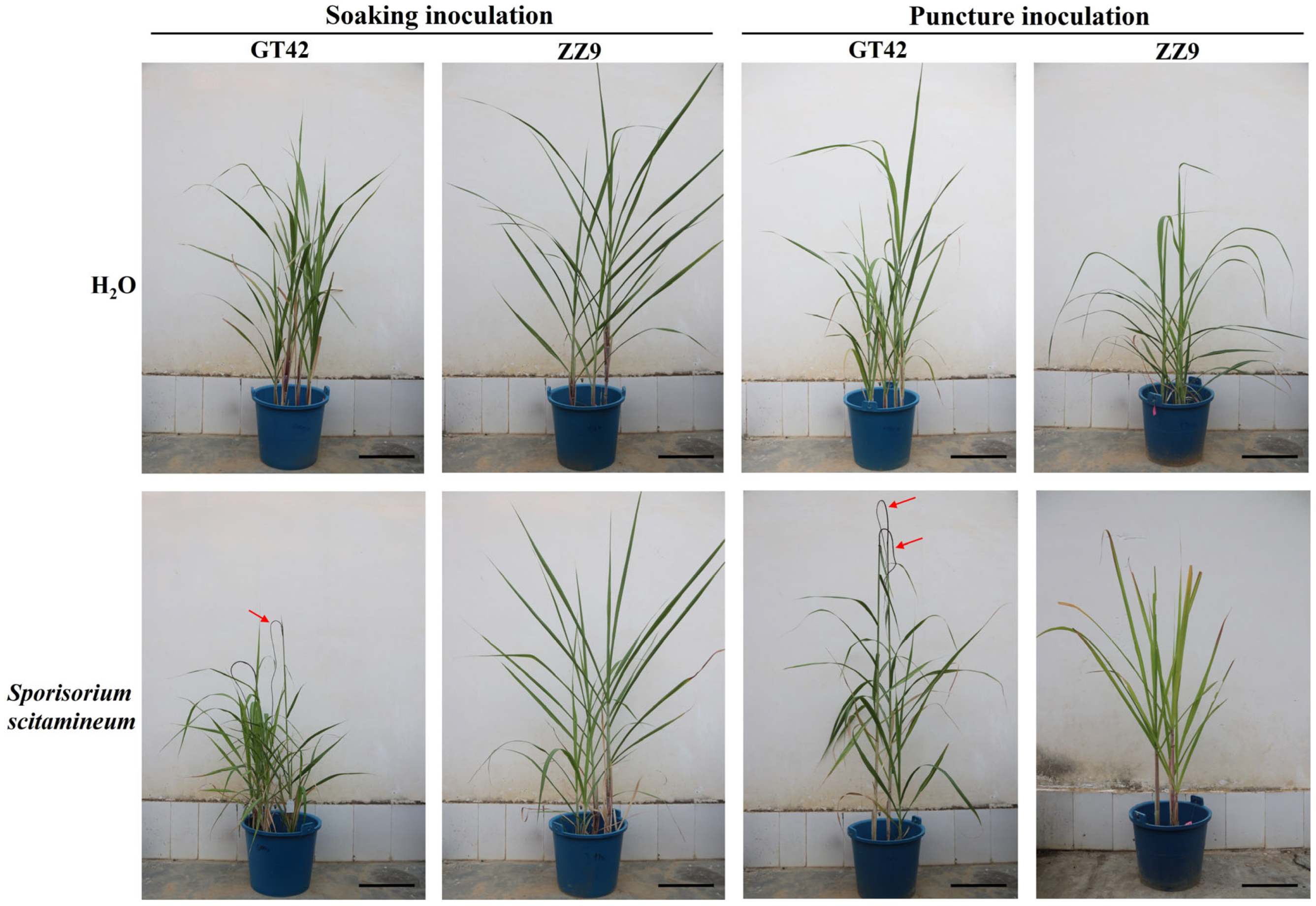

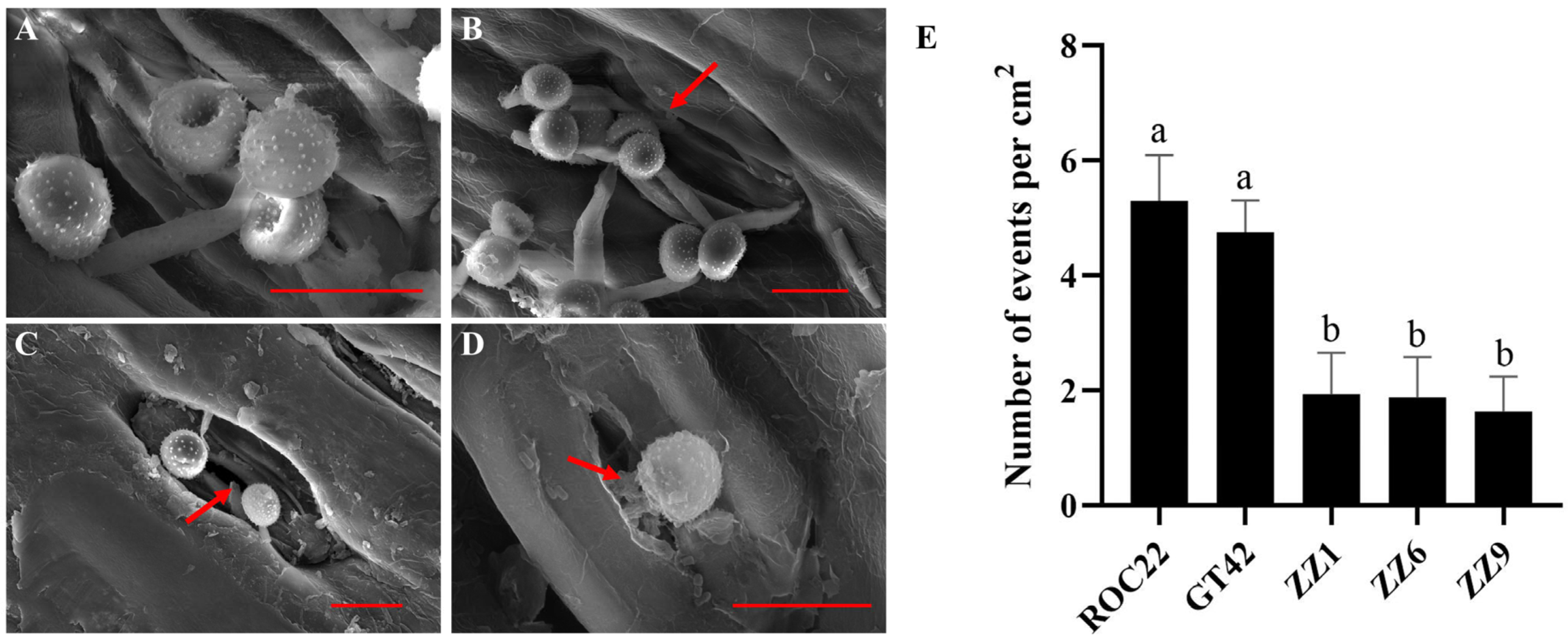
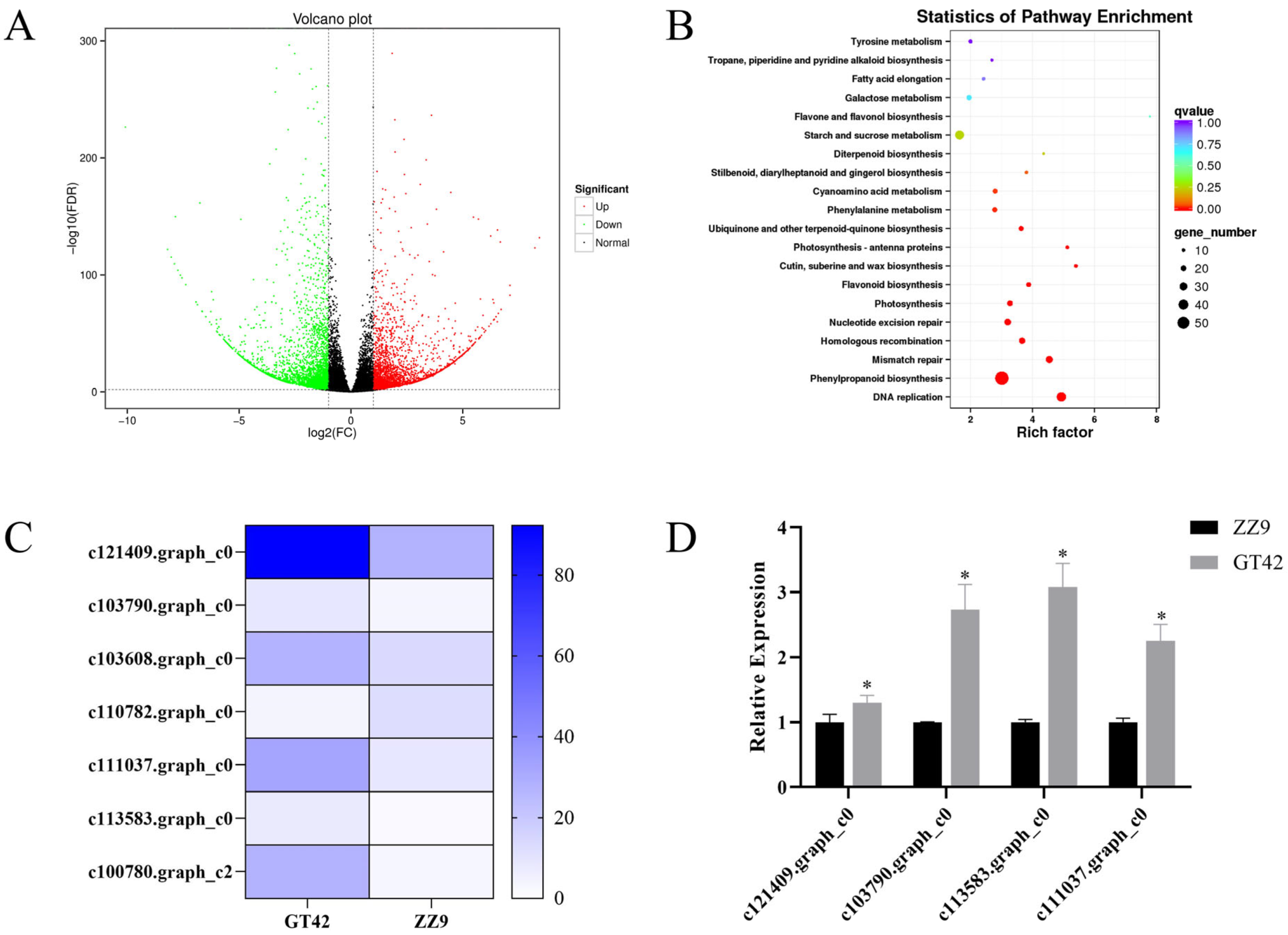
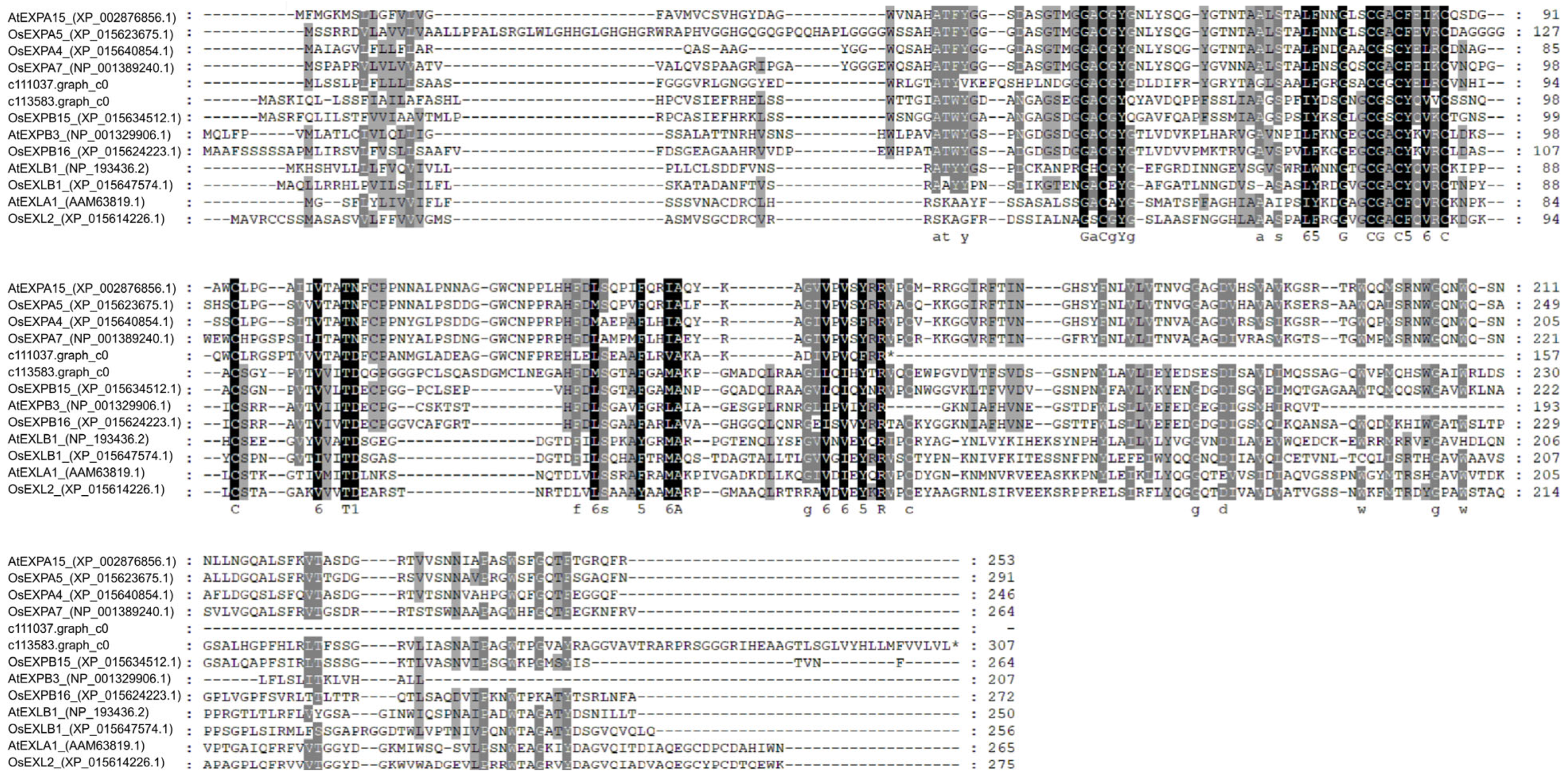
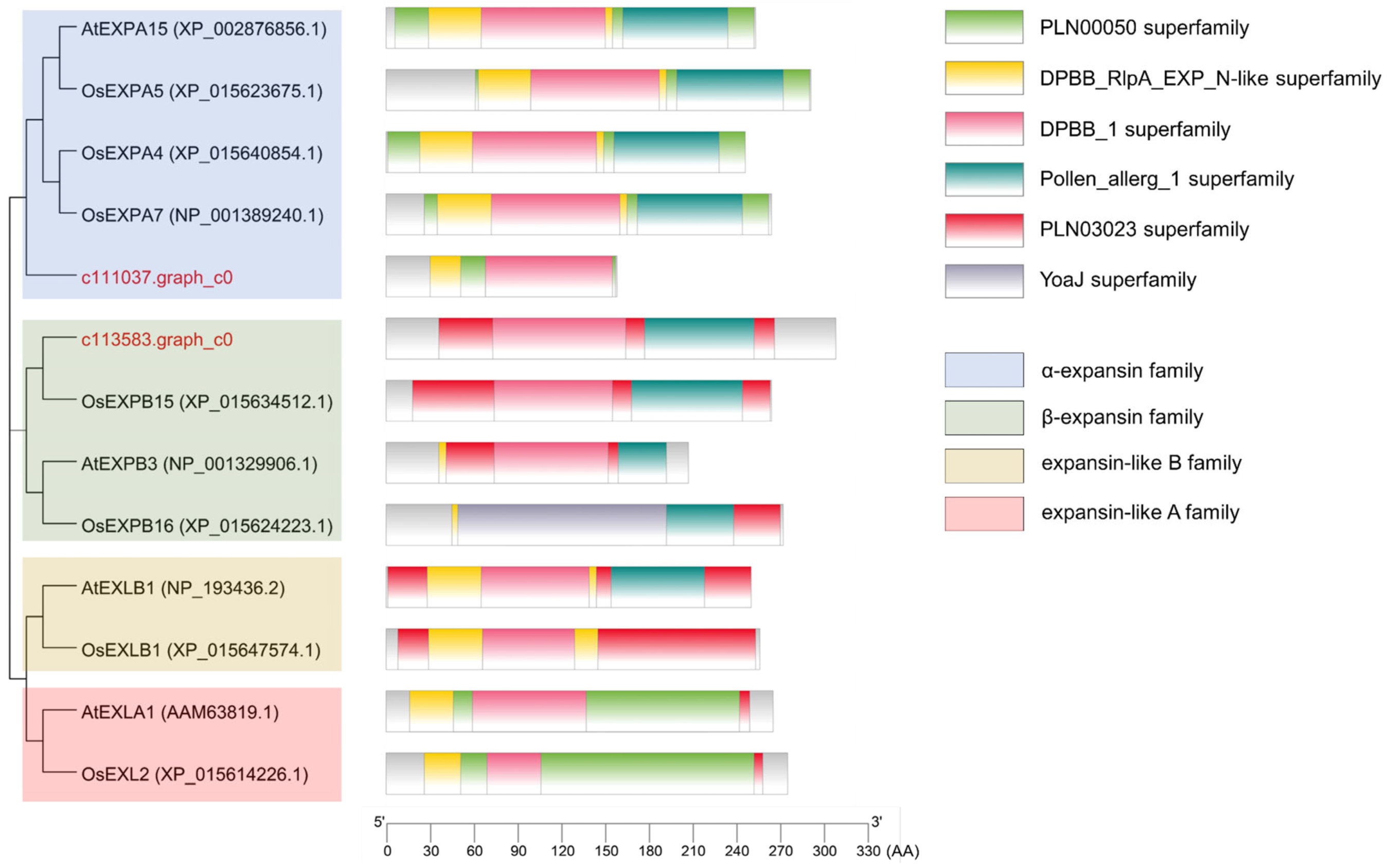
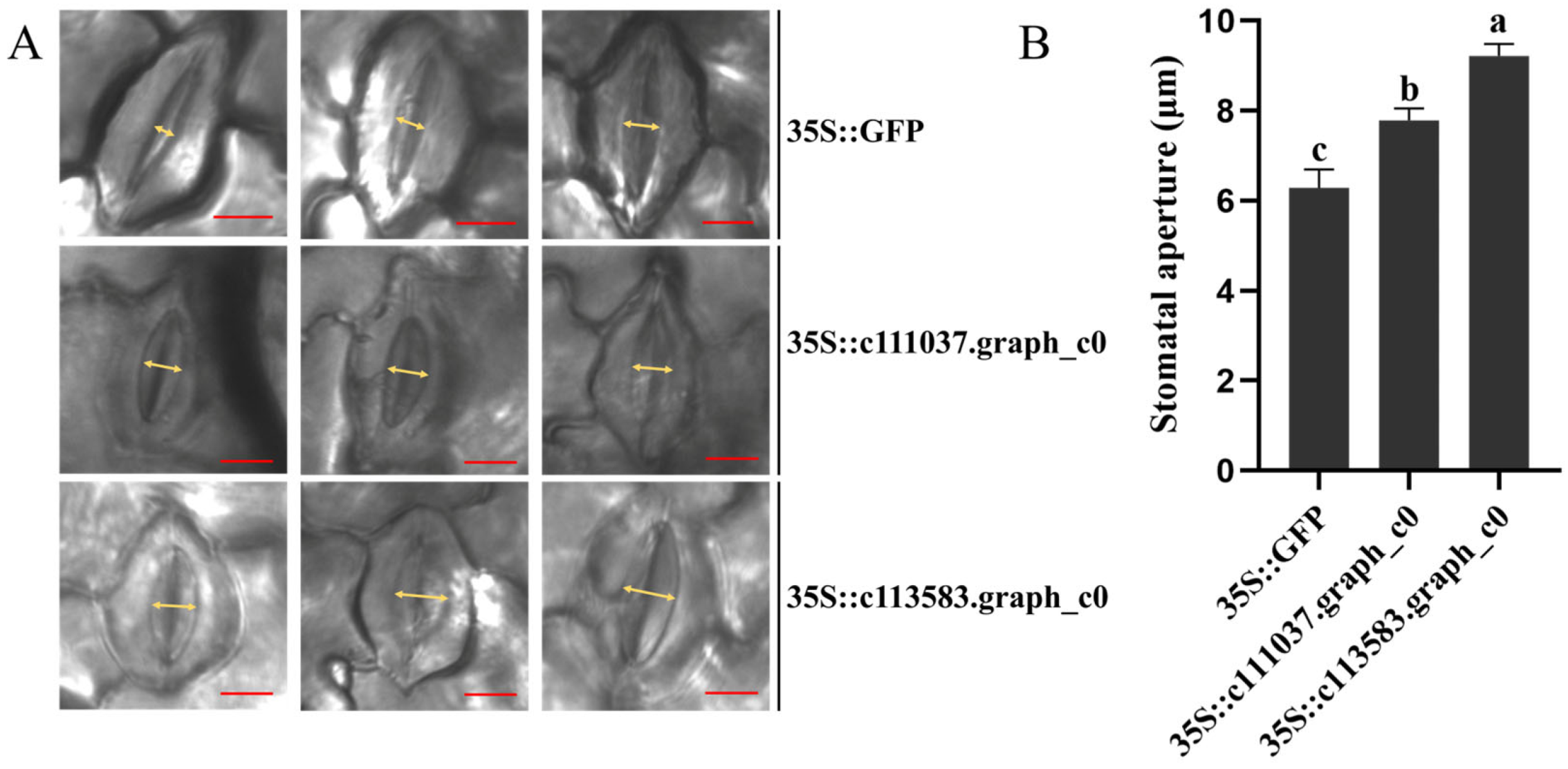
| Variety | Method | No. of Plantlets Inoculated | No. of Whips | Smut Incidence (%) |
|---|---|---|---|---|
| GT42 | Soaking inoculation | 50 | 23 | 46 |
| Puncture inoculation | 15 | 9 | 60 | |
| ZZ9 | Soaking inoculation | 50 | 0 | 0 |
| Puncture inoculation | 15 | 1 | 6.67 |
| Gene ID | GT42 | ZZ9 | log2FC | FDR | Description |
|---|---|---|---|---|---|
| c121409.graph_c0 | 92.516667 | 28.156667 | 1.0440377 | 9.27 × 10−51 | Expansin-B11 |
| c103790.graph_c0 | 8.4166667 | 3.2266667 | 1.4529291 | 1.1 × 10−9 | Expansin-like A4 |
| c103608.graph_c0 | 26.753333 | 12.603333 | 1.1398525 | 6.26 × 10−14 | Expansin-B16 |
| c110782.graph_c0 | 3.6666667 | 11.506667 | −1.413006 | 2.65 × 10−12 | Expansin-like A2 |
| c111037.graph_c0 | 31.573333 | 8.6633333 | 1.7396968 | 7.39 × 10−28 | Expansin-A16 |
| c113583.graph_c0 | 7.3566667 | 2.0033333 | 1.6267807 | 3.89 × 10−18 | Expansin-B12 |
| c100780.graph_c2 | 27.056667 | 3.23 | 2.7556978 | 2.76 × 10−29 | Expansin-B7 |
Disclaimer/Publisher’s Note: The statements, opinions and data contained in all publications are solely those of the individual author(s) and contributor(s) and not of MDPI and/or the editor(s). MDPI and/or the editor(s) disclaim responsibility for any injury to people or property resulting from any ideas, methods, instructions or products referred to in the content. |
© 2024 by the authors. Licensee MDPI, Basel, Switzerland. This article is an open access article distributed under the terms and conditions of the Creative Commons Attribution (CC BY) license (https://creativecommons.org/licenses/by/4.0/).
Share and Cite
Liu, Z.; Yu, Z.; Li, X.; Cheng, Q.; Li, R. Two Sugarcane Expansin Protein-Coding Genes Contribute to Stomatal Aperture Associated with Structural Resistance to Sugarcane Smut. J. Fungi 2024, 10, 631. https://doi.org/10.3390/jof10090631
Liu Z, Yu Z, Li X, Cheng Q, Li R. Two Sugarcane Expansin Protein-Coding Genes Contribute to Stomatal Aperture Associated with Structural Resistance to Sugarcane Smut. Journal of Fungi. 2024; 10(9):631. https://doi.org/10.3390/jof10090631
Chicago/Turabian StyleLiu, Zongling, Zhuoxin Yu, Xiufang Li, Qin Cheng, and Ru Li. 2024. "Two Sugarcane Expansin Protein-Coding Genes Contribute to Stomatal Aperture Associated with Structural Resistance to Sugarcane Smut" Journal of Fungi 10, no. 9: 631. https://doi.org/10.3390/jof10090631
APA StyleLiu, Z., Yu, Z., Li, X., Cheng, Q., & Li, R. (2024). Two Sugarcane Expansin Protein-Coding Genes Contribute to Stomatal Aperture Associated with Structural Resistance to Sugarcane Smut. Journal of Fungi, 10(9), 631. https://doi.org/10.3390/jof10090631







